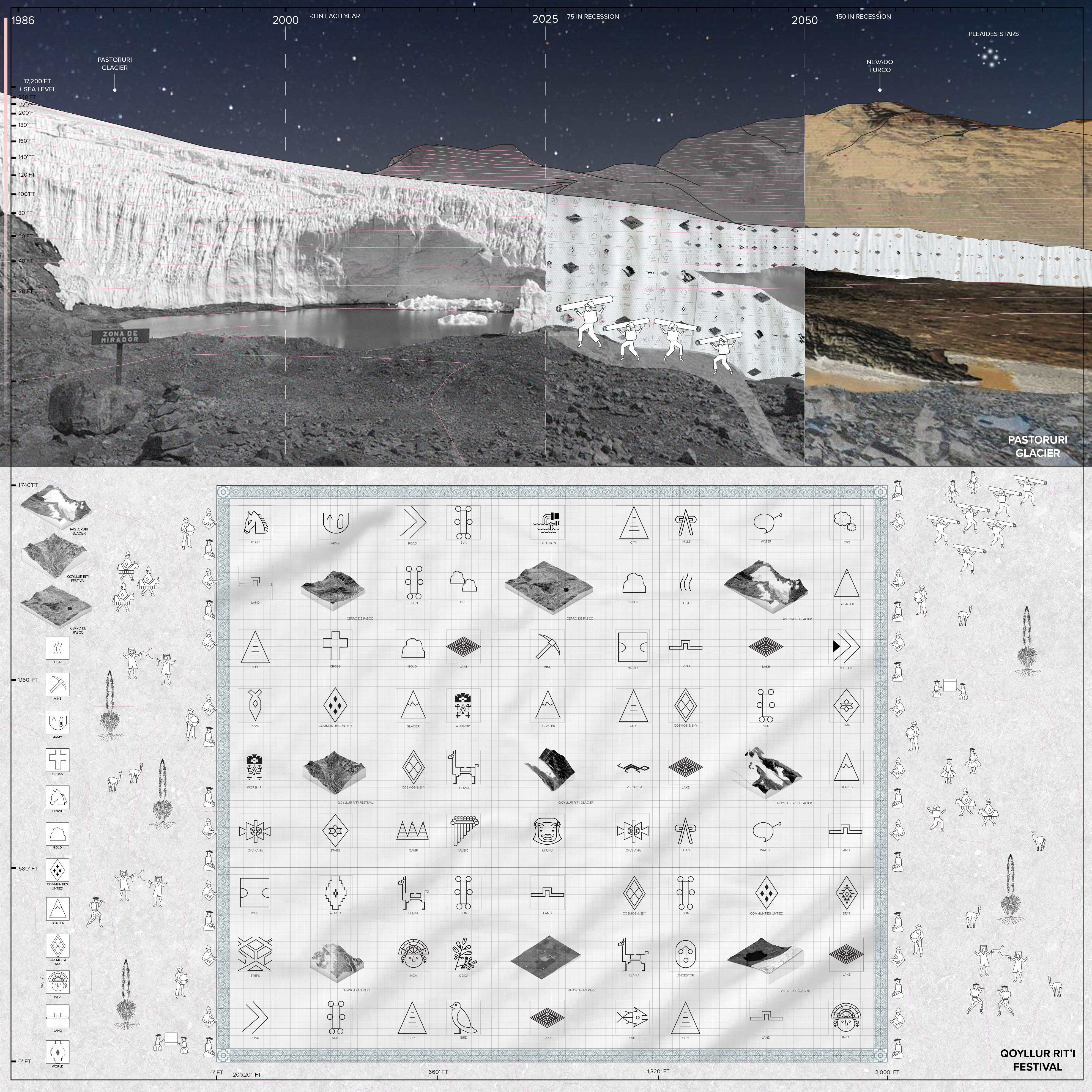PROFESSOR
EL HADI JAZAIRY
STUDIO
CAUTIONARY TALES FOR CLIMATE INHERITANCE
Cautionary Tales for Climate Inheritance investigates the threats that climate change poses to UNESCO World Heritage sites, which are outlined at risk of degradation from rising sea levels, superstorms, wildfires, worsening droughts, and melting glaciers.
Cautionary Tales for Climate Inheritance is a speculative design studio that narrates such climate threats to World Heritage sites and explores possible futures of responsible tourism. Inspired by the significant global attention over the Notre Dame Cathedral fires, the studio casts the UNESCO sites as characters in climate change cautionary tales to anchor the abstract planetary imagination of climate change. The investigation begins with a few iconic sites and buildings that become characters in a story about the planet in crisis; not unlike the Micheangelo Antonioni’s Eolian islands or John Hejduk’s masks. It is at this moment when the planet is in crisis that a collective imaginary could propose new narratives, situations, and practices that guide the values of heritage, conservation, monuments and tourism.
︎︎︎BACK ︎
MARÍA ARQUERO DE ALARCÓN + ANA PAULA PIMENTEL WALKER**
Volume 01 + 02
CRAIG BORUM
Chen Huang
Yunyan Li
EL HADI JAZAIRY**
Judith Mendoza, Rosa Manzo, Tessa Broek
Renwei Liu,
Lu Li
MICK KENNEDY
Chun-Li Julie Chen
Ellis Wills-Begley
JEN MAIGRET
Nicolai Carlson, Megan Clevenger, Song Gao
Yuyan Wang, Xiangqi Wen, Haoyu Zhou
ROY STRICKLAND**
Kael Fineout
Victoria Wong
GEOFFREY THÜN**
Marco Nieto, Kady Cramer
Ian Eichensehr,
Jonathan Levitske,
John Lozinak
KATHY VELIKOV**
Gina Laudato,
Jasmine Wright
Fernando Rosas, Madison Wong
STUDENT WORK
JUDITH MENDOZA, ROSA MANZO,
TESSA BROEK
“GLACIAL INHERITANCE”
Huascaran National Park of Peru is home to some of the largest tropical glaciers severely impacted by climate change. The glaciers are melting faster and freshwater is becoming scarce for much of Peru. While there is urgency to slow down the effects of climate change and preserve the glaciers in their frozen state, we believe in the inherent right of glaciers to melt or evaporate and as such seek to protect them in their various states. The project identifies three sites of intervention dependent on the Huascaran: the city and mine of Cerro de Pasco, Antamina Mine, and agricultural lands of the foothills.

01:ISSUE: A visual narrative of the historical, social, geological, and political issues surrounding the Huascaran National Park and how they are being impacted by (or are actively ignoring) climate change.

02:POSITION: A stance condemning the presence of national and foreign entities mining the Huascaran and poisoning the land, communities, flora, and fauna.

03: STRATEGY: A proposal to remediate abandoned and current mining sites as wetlands and protected biosphere reserves.

04: During the Spanish colonization period, Incas were uprooted from their land, and massive land abuse emerged through mining operations. Cerro de Pasco, a mining city, is living evidence of what human consumption has led us to, a scar that is slowly devouring its city by poisoning communities with lead and heavy metals through water, soil, and air pollution, ultimately eradicating the nearest glaciers. The project proposes to seal the mine to gradually restore the conditions of contaminated soil, water, and air. In exchange, a memorial will honor those who were lost, including the nearest glaciers.

05: The project proposes limestone towers and indigenous Andean water-management landscape interventions to memorialize, clean and redistribute the arid region’s scarcest resource. Two types of towers mark the time and water reclamation through the sculpting and discoloration. The mesh of the gabion cage breaks down over time releasing the crushed limestone. The water then filters through parallel constructed anaerobic wetlands composed of layered limestone, organic matter, and submerged aquatic plants. The intervention's final step deposits the water in the porous soil of the mountain through the use of amunas or canals which work by slowing the water's descent.

06:The project is a visual guide proposing a variety of water catchment and reclamation systems to conserve and filter glacial runoff due to climate change. The project recognizes the right of the glaciers to melt and vaporize and as such, seeks to protect the glaciers in their various states by condensing, collecting, filtering, and absorbing it back into the rich Huascaran land, supporting agricultural efforts in the process and recharging local groundwater sources.

07:This project recognizes Peru's annual festival, Qoyllur Rit'i, the festival of stars. Every year, tens of thousands of pilgrims gather at one of many of Peru's sacred glaciers. This time, the journey will occur at Pastoruri glacier, one of the most rapidly retreating glaciers in the world, where communities bring together a blanket to slow the melting process while embedding their stories in relation to water, memory, and honor of the glacier. Every year the blanket remains for more prolonged periods until soon it lays as a reminder of what it used to be.

08:The project re-establishes local land sovereignty through the architecture of mine water reclamation after a long history of occupation and resource extraction. In addition to the limestone towers, the wetlands and settling pond are divided by terrace walls to accommodate the shift in elevation. The walls themselves echo the Inkan strategy of building upon natural rock outcrops as a symbol of their sovereignty, a visual reminder of the land's transition from the chaos of nature to the built order. The mine functions here as a rock outcrop marked and reshaped by successive empires.

09:This project considers agricultural sites as sites for a new axis mundi where
water is the activating agent, colliding the celestial and earthly realms,
evoking reverence for the landscape and glacial water and defining land rights
for indigenous inheritors of the region. This proposal builds on Incan mortuary
structures and environmental management practices as a response to extractive
colonial and post-colonial land and human exploitation.
